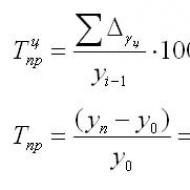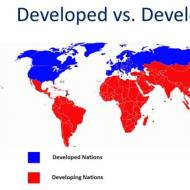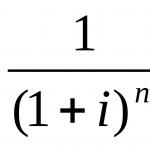
Long waves in economics briefly. Abstract: Long waves in economics and theories explaining their existence. Fundamentals of the theory of ethnogenesis
Long wave theory (theory of long waves listen)) is a theory of business cycles lasting from 40 to 60 years, developed by Russian economist Nikolai Kondratiev.
At least since the industrial revolution in England, economic development has been significantly influenced by large economic cycles, also known as “Kondratiev's long waves” - in honor of their largest researcher, the Russian economist Nikolai Dmitrievich Kondratiev. N. Kondratiev should have shared this honor with another outstanding economist of the 20th century J. Schumpeter, author of the fundamental works “Business Cycles” and “Theory economic development"Kondratiev and Schumpeter were not the discoverers of large cycles. Their existence was noticed by W. Jevons (1884), K. Wicksell (1898), M. Tugan-Baranovsky (1894) and many others. What is the merit of N.D. Kondratiev ? In his analysis, he covered the entire history of capitalism, using statistics from England, Germany and other countries, Kondratiev identified two groups of economic processes: wave-like (reversible) and evolutionary (irreversible), thereby developing the theory of long waves. (trend), while the former are cyclical in nature. He made a serious attempt to combine cyclical processes into. unified system, highlighting:
- seasonal cycles (up to 1 year);
- small (2-4 years);
- commercial and industrial (7-11 years);
- long cycles (50-60 years).
This approach is now widely accepted. Table 2.1 gives a modern understanding of the system of economic cycles.
Table 2.1. Conditional distribution of oscillations along wavelengths
| Range, years |
Wavelength, years (arithmetic mean) |
Approximate values (approximation) |
|
| in fractions of a century | in years | ||
| 2-4 | 3 | 1/32 | 3,125 |
| 4-8 | 6 | 1/16 | 6,25 |
| 8-16 | 12 | 1/8 | 12,5 |
| 16-32 | 24 | 1/4 | 25 |
| 32-64 | 48 | 1/4 | 50 |
It was the breadth and universality of the approach that predetermined the high assessment of his work by the outstanding economists of the 20th century J. Keynes, S. Kuznets, W. Mitchell, I. Fischer, J. Schumpeter. Thanks to Kondratiev, large cycles of market conditions have received universal recognition.
The next step in the development of the theory of long waves was made by J. Schumpeter, who connected cycles with innovations and their unevenness. Thus, we received an explanation for the problem of uneven rates economic growth, government activity and its impact on economic growth rates, and many others.
What are big economic cycles? Most economists agree that large cycles are inherent in the industrial system, and therefore the beginning of the first cycle coincides with the beginning of the industrial revolution (around 1790). The peak of the first wave occurs around 1813-1815. The second wave covers the period from the late 40s of the last century to the 90s (peak of the second wave - approximately 1870), the third wave covers the period from the late 90s of the 19th century to the end of the 30s of the 20th century (peak - approximately 1920), the fourth wave lasted from the late 30s to the late 80s of the XX century; the beginning of the last, fifth wave occurs in the 90s of the 20th century. Each new wave is caused by major shifts in the development of productive forces, the use of fundamentally new technologies, which gradually causes reconstruction of other industries, major structural changes in the economy, changes in the functions of the state, a change in technological leader states, fluctuations in key performance indicators, etc. In order to more clearly imagine large waves, we present a simplified version of the diagram (Table 2.2) by the English economist H. Freeman.
Table 2.2. Some characteristics of great economic waves
| Large cycles |
Content | Main load-bearing industry |
Countries - technological leaders |
| I | Early fur- nization |
Textile pro- thinking and textile ma- tire manufacturing |
Netherlands, Great Britain Tania, Belgium |
| II | Steam propulsion gatel and useful expensive gi |
Railways, construction, mechanical engineering |
UK, France, Belgium, Germany, USA |
| III | Electrotech- nick and heavy loye machine- structure |
Electricity ka, mechanical engineering- tion, the main chi- Mia |
Germany, USA, Great Britain Britain, France, etc. |
| IV | Mass production |
Car-, tractor mechanical engineering, production then- long-term var use, syn- theoretical mathematics rials |
USA, Germany and others EEC countries, Japan, Sweden, etc. |
| V | Computer science and telecom nication |
Electronics, computer, robot structure, information mation services |
Japan, USA, EEC, Thailand Wan, Korea, etc. |
Each wave has two main stages: upward and downward (according to N. Kondratiev). What patterns are characteristic of them? Before the start and at the beginning? each wave there are profound changes in technology and production technologies, the involvement of new countries in world economic relations, and an increase in social upheavals (wars and revolutions). The upward stage is characterized by an acceleration of economic growth, an increase in the average rate of profit, wages, falling prices. The second (downward) stage of the large cycle is characterized by a slowdown in economic growth, a fall in the average rate of profit, an increase in the average price level, depression in agriculture, and sharper fluctuations in the industrial (average) cycle. The most significant technical discoveries and inventions occur at the end of a big wave. From the point of view of Kondratiev and especially Schumpeter, such changes in dynamics are explained by the fact that the widespread development of new technologies (implying an increase in entrepreneurial activity) requires a fairly significant structural restructuring of the economy, the search for new sources of raw materials and energy resources. The introduction of new technologies initially causes an increase in the return (profitability) of production factors. Labor productivity and the marginal productivity of labor, capital, and land are growing. All types of income grow accordingly: wages, interest, business income, rent, quasi-rent (profit). Gradually, the capabilities of this generation of technology and developed resources are exhausted, and the law of diminishing returns begins to manifest itself with full force. The aggravation of economic problems and contradictions stimulates the search for new solutions. That is why discoveries are “concentrated” in the downward part of a large cycle, and their development gives impetus to a new wave.
N. Kondratiev, who analyzed 2.5 waves, considering the growth of social upheavals as a pattern of upward stages of a large cycle, illustrates it with the following historical events. Beginning of the I large cycle: declaration of independence of the USA, French bourgeois revolution, Anglo-French war, Russian-Turkish war, Napoleonic wars, etc. Beginning of the II cycle: revolution of 1848-1849 in France and Germany, in other countries, Crimean War, Civil the war in the USA, the Paris Commune, the formation of the German Empire, etc. The first half of the III great cycle: Spanish-American, Anglo-Boer, Russian-Japanese and other wars, First World War, revolutions in Russia, Germany, Turkey, Hungary, reconstruction of the map of Europe according to the Treaty of Versailles. The first half of the IV cycle was accompanied by the Second World War, revolutions in China, a number of countries in Eastern Europe, the collapse of the colonial system and the restructuring of not only the map of Europe, but the entire world. The beginning of Kondratieff's 5th major cycle is accompanied by a new restructuring of the map of Europe: the liquidation of the socialist camp, the growth of conflicts on social grounds, and a change in the geopolitical situation in the world.
Thus, economic growth and socio-economic progress, expressed in the growth of well-being, culture, and education of members of society, are uneven. It is accompanied by sometimes less and sometimes deeper economic fluctuations. Moreover, these fluctuations themselves initiate economic growth, that is, they are not only a consequence, but also a source of the latter. Social upheavals are not so much a consequence of growth as the result of people's inability to recognize the need for change and adapt to it.
Basics of economic theory. Lecture course. Edited by Baskin A.S., Botkin O.I., Ishmanova M.S. Izhevsk: Udmurt University Publishing House, 2000.
A market economy is characterized not only by small (up to 10 years), but also by large
cycles with long-term trends) (waves), lasting 50-60 years,
including decreasing and increasing phases. ,
Fundamentals of the theory of long-term economic fluctuations, or; large cycles
market conditions were laid at the beginning of the 20th century; There are five most famous
concepts of long will Kondratiev (reproductive), Schumpeter
(innovative).
Trotsky (the concept of crisis of the capitalist system), demo-|
graphic, military cycles. Largest contribution in the development of theo-; long wave ries
contributed by the prominent Russian economist N.D. KondraCh. Tiev, who published in the 20s
a number of works. In them the scientist is;; thematized the accumulated and processed by him
empirical material, made some generalizations, thereby laying the foundation for
basics of long wave theory1.
Briefly, the essence of the theory of long waves is as follows:! development of capitalist
economy is characterized by a sequential alternation of periods
slow and accelerated growth, each of which is two-fold in length
three decades. The main elements of the mechanism that reproduces; ,
long-term periodic fluctuations in the economy are the turnover of the main
capital with a long service life, accumulation of free money capital,
scientific and technical progress. Consequently, N.D. Kondratiev first became a
View scientific and technological progress as an internal factor of long-term cyclicality. Having processed
statistical data for 140 years on the average level of commodity price dynamics,
interest on capital, nominal,
1 The concept of large cycles of economic conditions entered scientific circulation under the name
cycles (waves) of Kondratieff.
cash wages, turnover foreign trade, coal production and consumption,
production of cast iron and lead, N. D. Kondratiev identified three large cycles
conditions: the first wave - from 1790 to 1850, the second - 1851-1890, the third -
from 1891, which in 1920 entered a downward phase.
N. D. Kondratiev saw the main goal of his research in the development
methodology for long-term trend forecasting
tions of the development of the world capitalist economy, i.e. he left for
capitalism is the ability to develop, evolve over long cycles. However
these conclusions sounded discordant with the general enthusiasm at that time for the idea of
the inevitable and immediate collapse of the economic system of capitalism. That's why
Kondratieff's theory of long waves was forgotten for a long time as harmful and
insolvent.
Ш However, the merit of N.D. Kondratiev in the development of economic theory is great. In-
first, he formulated the idea of a forecast plan (indicative planning, even
this has not yet happened in the West). Now the entire planning system is a plan-
forecast (pre-li see to manage). Secondly, in their forecasting
1, lan forecasts of cost indicators (previously there were material-1
real indicators). Combination of material and cost
indicators allowed us to develop financial forecasts. Thirdly, N.D.
Kondratiev proposed the use of deflators, introduced price statistics, which
allowed V-C to improve the dynamics of production. Fourthly, introduced into economic
Shauku current market analysis, i.e. assessment of the current price change,
consumer basket. Fifthly, he developed the idea of Isootpmoshekiya social and
economic factors economic growth, which for a long time has not
confessed. Today it (^represents a practical question. Thus, in
large cycles associated with scientific and technological progress, N. D. Kondratyev 1
I saw the logic of development and connected all cyclical development with them. I At the same time
he warned against bold plans and projections, and called on people to be realistic.
|, The revival of the theory of long waves is associated with the name of Austrian
economist I. Schumpeter and his work “Economic Cycles” (1939), where
this theory received further and more complete development. Work by I. Schumpeter
occurred during the period of changes in the mechanism of functioning of the market economy
Miki. Subsequently, with a way out of the crisis situation, accelerate-1; slow pace
economic growth, interest in the problem of long-E temporary fluctuations is practically
completely disappeared. But in the ruble of the 60-70s there is again a return to
this problem, which is associated with the entry of a market economy into phase B
restructuring of its basic operating principles. Search |; ways to improve
production efficiency due to the exhaustion of the previous capabilities
mechanism of self-expansion of ka-R, fed, manifested in the Keynesian crisis
recipes adjust-
294 Chapter 14. Cyclicality of economic growth and economic development
lation economic life, made many economists think about
question: is the disorder of the world economy in the 70-80s
(expressed in more frequent crises, mass unemployment and accelerating inflation
processes) manifestation of long-term periodic oscillations, internally
existing economic system, and what is the mechanism of these fluctuations. Long wave idea
in the economy, supported by additional -! our research and new
statistical information, received its rebirth. A special role in this
played by the book of the German scientist G. Mensch "Technological stalemate: innovation
overcome depression" (1975). I
With all the diversity of points of view on the specific mechanism of long waves, all
the work of modern Western economists follows the lines proposed by J. Schumpeter
direction that explains the emergence of long-term trends unequally*
the dimension of scientific and technological progress. The main reason long-term
I. Schumpeter saw economic fluctuations in that! that the introduction of basic innovations
(such innovations that significantly change both the set of proposed
purchase-| products, as well as the technology for their production) is happening! Not
continuously, but periodically. At that moment when the creature-| previously created set
products completely filled the market, when further expansion of production
can only come from disused goods, and the old technology
does not make it possible to produce anything fundamentally different from what is already
manufactured product (i.e. through partial modernization and improvements), it is impossible
significantly expand the market, not to mention creating a new one.
This situation of extreme market saturation periodically recurs.
The application of new basic innovations causes rapid growth in production in
advanced industries, which stimulates growth and restructuring of the entire
economy. But as the market becomes more crowded, the economy
The crisis situation is growing, requiring the creation of new prospects! markets,
giving scope for self-expansion of capital. Each new extension
economy, each new wave changes the very mechanism of functioning
market economy. ?
I. Schumpeter not only developed the theory of innovation, but tried to combine
periodization of long waves with characteristic ne-i-riodal scientific and technical
revolution. Thus, he associated the wave of 1787-1842 with the industrial revolution:
the introduction of steam engines into production and the creation of textile and
metallurgical? some industry. During the next wave 1842-1897
there was accelerated development in the field of transport (railroads and steam
shipping). The third wave, which began in 1897 and ended in the late 30s and 40s
years of our century, he associated with the development of the automotive industry, chemical
industry and the widespread introduction of electricity.
§ 4. Long waves of economic development
The theory of long waves is characterized by two most important features: four-phase (as in
small cycle) oscillatory process of a long wave with a period of about half a century and
the great impact of scientific and technical progress on economic development, indicating the unity
and the interaction of economic development and long waves.
Five technological methods are taken as the material basis for large cycles
production:
early mechanization 1770-1840 Key indicators - cotton, cast iron,
textile engineering. The leaders were Great Britain, France, Belgium;
steam power and railroads 1840-1890 Key indicators - steam locomotives,
steam ships, machine tools, railway equipment, world shipping. Leaders
Great Britain, France, Belgium, Germany, USA;
electricity and heavy engineering 1890-1940. Key indicators -
steel, cars, airplanes, radios, aluminum, oil, durable goods
use. Leaders - Germany, USA, UK, France, Belgium,
Switzerland, the Netherlands;
Fordist mass production 1940-1990 Key indicators - energy,
computers, radars, machine tools, nuclear weapons and energy, missiles, microelectronics
software. Leaders - USA, Germany, Japan, Sweden, Switzerland,
information and communications since 1990 Key indicators - microelectronics,
biotechnological production, space activities, fine chemistry. Leaders
Japan, USA, Germany, Sweden, Russia.
IN last years interest in the theory of long waves has sharply increased among domestic
researchers. Publications of such scientists appeared in the economic literature:
like S. Menshikov, S. Nikitin, S. Aukutsionek, Y. Shishkov, Y. Yakovets, A. Poletaev,
R. Entov, Yu. Osipov and others, in which ideas about long-term trends in development
world economy are being explored and developed further.
However, the problem of long waves remains quite controversial:
different views on the nature of long waves and the mechanism of their occurrence. Undisputed
the same is the recognition of their existence and the use of the concept of long waves
to characterize economic processes that do not find their
explanations in small cycle theories (for example, the reasons for a serious slowdown
economic growth rates in the 70-80s).
Long-term trends in economic development are associated with obsolescence
material and technical basis of production, with exhaustion of resources
long-term development and economic growth. Qualitative change
productive forces, capable of providing a new long-term rise, changes and
296 Chapter 14. Cyclicality of economic growth and economic development ||
biological mechanism, bringing it into line with the level of development of productive
The mechanism of long-term fluctuations is associated with the movement of the rate of profit. Sufficient
profitability of private enterprise is economic basis For
implementation of the results of technical progress. That's why long waves
represent not just an alternation of high and low growth rates, but their own
a kind of long-term economic development based on the law of profit. Norm
profit is, on the one hand, an indicator of production efficiency, on the other hand
on the other hand, it is a stimulus and regulator of the reproductive process. Decline
profits reflect a decline in economic efficiency and an increase in overaccumulation of capital.
To solve these problems, a structural restructuring of the economy is needed, modification
economic mechanism. Therefore, extraordinary measures are being taken: sharply
the innovative activity of entrepreneurs increases, liquidation or
traditional industries are being transferred to a fundamentally new technical level
production, the forms and methods of organizing labor and the use of labor are changing
The process of long-term cyclical fluctuations in the market economy is confirmed
practice. If we take as the turning points of the long wave the most
deep economic crises, we can distinguish the following long-term
Wave 1825-1873 - a period of free competition. An adequate
capitalism has a technical basis, the industrial revolution occurs in the main
countries of continental Europe. The further development of capitalism is complicated
strong feudal remnants on the periphery of the capitalist-tyair. When
the fall in the rate of profit reaches alarming limits and it is impossible
compensate by expanding the scale of production, there is a need for
structural restructuring of the economy. This is achieved through the formation of monopolies
in the main sectors of the economy and obtaining additional profit.
Wave 1873-1929 - the period of formation and flourishing of diversified
monopolistic structures. Free competition turns into competition
regulated, monopolistic. Based on the development of productive forces
the possibility arose of accelerating the accumulation of capital, although it was restrained as
usually cyclical crises. Although capitalism covers the whole world, but
Such a development factor as territorial expansion is exhausted. With growth
number of monopolistic industries, fluctuations in the industry rate of profit
make the diversified structure unstable, and in the case of long-term
a decrease in the rate of profit is an obstacle to the self-expansion of capital. As a result
further growth of the diversified monopoly structure becomes
impossible in any
§ 4. Long waves of economic development
I sectoral, nor in territorial terms. Capital accumulation and I technical
production re-equipment has exhausted itself.
Wave 1929-1975 The reaction to the decline in efficiency is one-I industry
monopolistic structure becomes the growth of government intervention in
economy, creating benefits | clear conditions for changing the functional
capital structure, transition to a diversified enterprise structure. From school
In the 50-60s, the state government significantly updated [production
base, special development received dynamic I industries, created
diverse and inclusive economic infrastructure, broad development
received a [non-productive sphere, science began to turn into non-[
means productive force. These changes have provided unprecedented
intensity of capital accumulation. At the same time, there is an increasing tendency towards
overaccumulation of capital. In conditions of long-term decline in the rate of profit
factors that counteract the fall in the rate of profit are intensively used,
[primarily pricing levers. As a result, government
regulation contributed to the separation of the process of capital accumulation from objective
market regulators, led to a hidden increase in overaccumulation of capital,
acceleration of inflation processes. State stimulation of diversified
[the structure of enterprises created obstacles in the formation of [macroeconomic
proportions. And the limitation of state regulation by national
framework came into conflict with the need for self-growth
capital that is international in its essence. Deterioration of reproductive conditions in
70-80s was reflected in a decrease in the rate of economic growth, the
[activity and profitability of production, increasing inflationary [trends,
aggravated competition between individual [groups of financial capital.
Avoid another long-term crisis
Zisa failed.
I C economic crisis 1974-1975 one can barely distinguish
[the blowing wave of long-term development. Exit to increase
The solid phase in this wave is associated with the strengthening of economic potential
developed countries based on deep structural
Shifts (reindustrialization), rationalization of production | based on implementation
new equipment and technology, strengthening its (competitiveness. In
economic mechanism priority
Competition, the market, as well as private
Nopolistic regulation. State intervention in
Economic processes are decreasing while simultaneously intensifying
| understanding its role in ensuring strategic conditions for development
|and growth of competitiveness of developed countries.
I So, a market economy is characterized by both small and
[large cycles of economic development.
I Small and large cycles of economic development. Small
|and large cycles of economic development are not opposed to each other
298 Chapter 14. Cyclicality of economic growth and economic development
each other, but interact, complementing each other. This is expressed as follows:
both small and large cycles are a form of economic movement and development. In any
Kondratiev's greatest scientific merit is that he attempted to construct a theoretical socio-economic system that itself can generate long-term fluctuations.
In the second half of the 20th century, the study of long waves was carried out by such researchers as I. Schumpeter, S. Kuznets, K. Clark, W. Mitchell, P. Boccara, D. Gordon, T. Kuchinsky. In 1983, 1985, 1987, 1988 and 1992. International symposiums on long waves were held. In Russia, Yu. Yakovets, L. Klimenko, S. Menshikov, V. Klinov and others are currently working on long waves.
The long wave theory assumes that the economic system is constantly in a state of deviation from macroeconomic equilibrium. Firstly, these are deviations of demand from supply and vice versa over long periods of time. Secondly, these are deviations associated with changes in demand for equipment, structures, Construction Materials and so on. These deviations are overcome within the framework of industrial cycles of average duration. Thirdly, these are long-term deviations from equilibrium, the duration of which is 40-60 years. They occur in the markets for industrial buildings, infrastructure and labor. Note that the first and second types of deviations occur with the same technological method of production, within which a number of generations of equipment and technology change. After the possibilities for increasing efficiency within the framework of the scientific and technical principles used have been exhausted, there is a transition to the use of new scientific and technical principles, a transition to a new technological method of production. The era of scientific and technological revolution is coming. This transition takes considerable time and gives rise to a new long wave, which is currently happening in all industrialized countries. It can be argued that the market system in this regard has the ability to constantly stimulate scientific and technological progress, since society itself, based on a mixed regulated market system, is interested in this.
However, the greatest threat to macroeconomic stability comes from average economic cycles (from 3 to 11 years). These are wave-like fluctuations in the level of economic activity over several years.
Although individual cycles differ from each other in character and duration, they can still be divided into four typical phases (Fig. 33).
Rice. 33. Economic cycle and its phases
The cycle opens peak phase , meaning full (or almost full) employment of all resources in production. Thus, in the United States, 84% is considered a critical level of economic load, at which the business “overheats”, ceases to cope with consumer demand and creates the danger of rising prices.
Second stage - decline phase , or recession, – decrease, moderate decline in business activity in society; slowdown in economic growth, characterized by a reduction in production and employment, the third stage - depression phase – 1) depressed, depressed state, accompanied by physical and spiritual impotence; 2) decline, stagnation in the economic or cultural life of a country is accompanied by the fact that, having reached the lowest level (bottom), they “tread time” (stagnation) for some time, in order to then, as it were, “push off from the bottom” and begin their life-giving upward movement.
Finally, in revitalization phase level economic activity rises, and growing production and employment gradually turn into an upswing that continues to the highest point of a new peak (from which, later, another cycle may begin).
The immediate cause of periodic declines in production is a reduction in aggregate demand in society, which encourages producers to reduce economic activity. As a result, a “vicious circle” begins to operate: a decline in production → a fall in employment → a decrease in income → a reduction in total spending and demand → a new recession. It is not so easy for society to get out of such a vicious circle.
As for the factors causing the initial reduction in aggregate demand, they can be very different: replacement of worn-out equipment (previous purchases of raw materials, materials, spare parts are reduced), a drop in demand for individual species products, rising taxes and credit interest, “overheating” of the economy (overaccumulation of capital and overproduction of goods), bankruptcy of some kind large company, sharp fluctuations in the stock speculative game, violation of the law money circulation, strikes, wars, various political events, natural disasters and other unforeseen situations. All such deviations can break the existing market equilibrium and give impetus to the next economic recession. Here, as with a fire in the taiga: an insignificant cigarette butt can set a large forest on fire.
Crises are a turning point, an aggravation, a difficult transitional and dangerously unstable state of something (the economy, politics, international relations etc.) in the economy bring “trouble” to society - unemployment, bankruptcy, decreased income, disorganization of production, etc. But at the same time, some analysts note that periodically a crisis is necessary for any developing country.
In conclusion, we note that cyclical development is a manifestation of the very essence of production development, its natural property, the method of its progressive movement. Thus, cyclicality is evidence of the viability of a given social system, evidence of its right to exist.
Theory of long waves (cycles)(long wave (cycle) theory) is a concept (idea) about the existence of large temporary (50–60 years) cycles of economic conditions, which are based on fluctuations in commodity prices. The creator of the theory of long waves (cycles) is considered to be Nikolai Dmitrievich Kondratiev (1892–1938), who created a theory with the help of which it is possible to describe all types of cyclicality in the economy (both short 2–3 years and medium 7–11 year cycles) with the aim of forecasting its development for various periods and creating the foundations for real planning.
The first stage of the cycle in the theory of long waves according to Kondratieff is the “phase of capital starvation”, accompanied by an increase in the rate of production growth, growth in employment in the manufacturing industry and the service sector while maintaining employment in agriculture, an increase in the mining industry, an increase in interest rates and the export of capital (saturation investment demand).
The next stage of the cycle - the “phase of capital saturation” - is characterized by growth, a decrease in the rate of transition of employees from primary industries to manufacturing and the service sector, a reduction in the export of capital, and a low level of loan interest. National economic activity, according to Kondratiev, is associated with changes in resource prices. This conclusion is based on an analysis of long-term statistical data characterizing the economies of Great Britain, France, the USA and Germany according to 10 parameters (including national capital, population, production of means of production, wages, interest on capital, the amount of land rent, the amount of accumulated capital). The indicators are divided into two groups. The first one forms funds: population, amateur capital, etc. The second one forms flows: interest on capital, the amount of land rent, etc.
When processing data to identify major trends from time series Kondratiev used the least squares method, and to estimate average and short-term fluctuations - the moving average method. The change in economic conditions was described by Kondratiev as follows: an upward wave of 1780–1810 – a decline in the economic situation of 1810, 1817 and further until 1844–1851; promotion - 1844–1851 to 1870–1875; decline 1870 to 1890–1896; upward wave 1890–1896 to 1914–1920. In fact, an increase in economic conditions was actually observed until 1914–1920, after which there was a stage of decline until 1939–1945, and then until 1967–1973 – an improvement in economic conditions. The next recovery after the recession, which lasted from 1967–1973 to 1982–1985, occurred in 1982–1985.
According to Kondratiev, the emergence of large cycles of market conditions is caused by the turnover of fixed capital with a long service life, the accumulation of free money capital and scientific and technological progress (STP). Fluctuations in wages and transformation in foreign trade are associated with fluctuations general level commodity prices on world markets. Crises of overproduction are considered as part of changes in the general environment. Labor, fixed capital and scientific and technical progress in Kondratieff’s theory are presented as external (exogenous) factors of the economy (although modern science and considers models in which such factors are considered internal (endogenous) to be consistent with reality, but so far none of these models have been created).
The theory of long waves reflects processes as one of the processes of its self-regulation due to internal and external factors, and their differentiation determines the features of the model used. A number of domestic researchers have discovered a connection between long cycles and agrarian crises and rent relations; a connection has also been found between the theory of long waves and life cycles products and industries. The general rate of profit as a factor causing the emergence of the theory of long waves was considered by A. Poletaev.
Kondratiev's ideas were reflected in the works of G. Mensch, K. Freeman and other economists, describing the periodization of innovations and their impact on the economic situation. After the works of J. Schumpeter, the periodicity of the theory of long waves in economics was called Kondratiev waves, although there are few obvious supporters of this theory in the West. Using it in the 60s, a forecast of the economic potential of the United States for the 70s was built. The theory of long waves was used by B. Dickens to forecast the development of Great Britain.
Some facts that appeared in the world economy showed that Kondratiev was right: the invention of synthetic materials and micro-processors as external innovative factors, caused an upward wave. The social upheavals associated by the theory with an upward wave coincide with the predicted timing of the long wave theory (World War 2 and revolutions in Eastern Europe and China - 40s; “hot” summer in France; “hot” autumn in Italy, protests against racial discrimination in the USA – 60s; collapse of the USSR - 1989–1991).
The official economic science of the USSR denied the theory of long waves on the grounds that its predictions neutralize crises of overproduction at , and the declines and rises in production predicted by the theory contradict the dogma of Marxism-Leninism about the inevitability of the collapse of capitalism (Kondratiev himself was arrested in 1930 and died in prison) .
Practice has shown that business cycle irregular, the range of fluctuations and frequency vary. Economic theory recognizes:
- Kitchin cycles (3–5 years), resulting from a lag between changes in demand and the introduction of new means of labor;
- Juglar cycles (about 12 years), which reflect not only national, but also international conditions;
- cycles of S. Kuznets (about 20 years), as a plexus of various cycles.
The introduction of countercyclical policies developed by J. M. Keynes, or the state policy of indicative planning in France since 1946 by the de Gaulle government, as well as the switching of profitable industries by the state from new technologies to the latest (as practiced in Japan and the Republic of Korea), lead to that instead of cyclical economic development there is a “wave-like” one, growth rates change without crises, while the sanitizing influence of recessions decreases.
The synthesis of various concepts leads to the conclusion that the theory of long waves is a reflection of the features of evolution market system with its uneven development, imbalances, delays in responses to external influences, the effects of the entry of new countries into the world economic system, as well as the emergence of such new phenomena as global energy, food, and environmental crises. The theory of long waves is a form of socio-economic development of a market system in which the crisis phase is sanitizing, renewing, and fluctuations in market conditions are associated with changes not only in individual economic parameters, but also in factors of public mass consciousness, ideology and the evolution of conflicts of interest of various social groups.
A market economy is characterized not only by small (up to 10 years), but also by large cycles with long-term trends (waves), lasting 50-60 years, including downward and upward phases.
The foundations of the theory of long-term economic fluctuations, or large cycles of economic conditions, were laid at the beginning of the 20th century. There are five best known concepts of long waves:
Kondratiev (reproductive), Schumpeter (innovative), Trotsky (the concept of crisis of the capitalist system), demographic, military cycles. The greatest contribution to the development of the theory of long waves was made by the prominent Russian economist N.D. Kondratiev, who published a number of works in the 20s. In them, the scientist systematized the empirical material he had accumulated and processed, made some generalizations, thereby laying the foundations of the theory of long waves.
Briefly, the essence of the long wave theory is as follows: the development of a capitalist economy is characterized by a successive alternation of periods of slow and accelerated growth, each of which lasts two to three decades. The main elements of the mechanism that reproduces long-term periodic fluctuations in the economy are the turnover of fixed capital with a long service life, the accumulation of free money capital, and scientific and technological progress. Therefore, N.D. Kondratiev was the first to consider scientific and technical progress as an internal factor of long-term cyclicality. Having processed statistical data for 140 years on the average level of dynamics of commodity prices, interest on capital, nominal wages, foreign trade turnover, coal production and consumption, iron and lead production, N. D. Kondratiev identified three large cycles of the market situation: the first wave - from 1790 to 1850, the second - 1851-4®90, the third - from 1891, which in 1920 went into a downward phase.
The main goal of his research N.D. Kondratiev saw the development of a methodology for long-term forecasting of trends in the development of the world capitalist economy, i.e. he left behind capitalism the ability to develop and evolve over long cycles. However, these conclusions sounded dissonant with the general enthusiasm at that time for the idea of the inevitable and imminent collapse of the economic system of capitalism. Therefore, Kondratieff’s theory of long waves was forgotten for a long time as harmful and untenable. market economy cycle crisis
However, the merit of N.D. Kondratiev is great in the development of economic theory. Firstly, he formulated the idea of a forecast plan (indicative planning, even in the West this had not yet happened). Now the entire planning system is a plan-forecast (foresee in order to manage). Secondly, in forecasting he made forecasts of cost indicators (previously there were material indicators). The combination of material and cost indicators made it possible to develop financial forecasts. Thirdly, N.D. Kondratiev proposed the use of deflators and introduced price statistics, which made it possible to see the dynamics of production. Fourthly, introduced into economic science current market analysis, i.e. assessment current change prices, consumer basket. Fifthly, he developed the idea of the relationship between social and economic factors of economic growth, which had not been recognized for a long time. Today she presents a practical question. Thus, in large cycles associated with scientific and technological progress, N.D. Kondratiev saw the logic of development and connected all cyclical development with them. At the same time, he warned against bold plans and projections and called for being realistic.
The revival of the theory of long waves is associated with the name of the Austrian economist I. Schumpeter and his work “Economic Cycles” (1939), where this theory was further most fully developed. J. Schumpeter's work occurred during a period of changes in the functioning mechanism of a market economy. Subsequently, with the recovery from the crisis situation and the acceleration of economic growth, interest in the problem of long-term fluctuations almost completely disappeared. But at the turn of the 60s and 70s there was a return to this problem, which is associated with the entry of the market economy into the phase of restructuring its basic operating principles. The search for ways to increase production efficiency in connection with the exhaustion of the capabilities of the previous mechanism of self-expansion of capital, which manifested itself in the crisis of Keynesian recipes for regulating economic life, forced many economists to think about the question: is it not the disorder of the world economy in the 70s and 80s (expressed in the increasing frequency of crises , mass unemployment and accelerating inflationary processes) the manifestation of long-term periodic fluctuations inherent in the economic system, and what is the mechanism of these fluctuations. The idea of long waves in economics, supported by additional research and new statistical information, has been reborn. A special role in this was played by the book of the German scientist G. Mensch “Technological stalemate: innovation overcomes depression” (1975).
With all the diversity of points of view on the specific mechanism of long waves, all the work of modern Western economists goes in the direction proposed by J. Schumpeter, which explains the emergence of long-term trends by the unevenness of scientific and technological progress. I. Schumpeter saw the main reason for long-term fluctuations in the economy in the fact that the introduction of basic innovations (those innovations that significantly change both the set of products offered to the buyer and the technology for their production) does not occur continuously, but periodically. At the moment when the pre-existing set of products has completely filled the market, when further expansion of production can only take place at the expense of disused goods, and the previous technology does not make it possible to produce any product fundamentally different from the one already produced (i.e., through partial modernization and improvements), it is impossible to significantly expand the market, let alone create a new one.
This situation of extreme market saturation periodically recurs. The application of new basic innovations causes rapid growth in production in advanced industries, which stimulates growth and structural restructuring of the entire economy. But as the market becomes increasingly full, a crisis situation in the economy is growing, requiring the creation of new promising markets that give scope for the self-expansion of capital. Each new expansion of the economy, each new wave changes the very mechanism of functioning of the market economy.
I. Schumpeter not only developed the theory of innovation, but tried to combine the periodization of long waves with the characteristic periods of the scientific and technological revolution. So, the wave of 1787-1842. he associated it with the industrial revolution: the introduction of steam engines into production and the creation of the textile and metallurgical industries. During the next wave of 1842-1897. There was accelerated development in the field of transport (railroads and steam shipping). He associated the third wave, which began in 1897 and ended in the late 30s and 40s of our century, with the development of the automobile industry, chemical industry and the widespread introduction of electricity.
The theory of long waves is characterized by two important features: a four-phase (as in a small cycle) oscillatory process of a long wave with a period of about half a century and the great impact of scientific and technical progress on economic development, indicating the unity and interaction of economic development and long waves.
Five technological production methods are taken as the material basis for large cycles:
early mechanization 1770--1840 Key indicators - cotton, cast iron, textile engineering. The leaders were Great Britain, France, Belgium;
steam power and railways 1840--1890 Key indicators - steam locomotives, steam ships, machine tools, railway equipment, world shipping. Leaders - Great Britain, France, Belgium, Germany, USA;
electricity and heavy engineering 1890--1940. Key indicators - steel, cars, planes, radio, aluminum, oil, durable goods. Leaders - Germany, USA, Great Britain, France, Belgium, Switzerland, the Netherlands;
Fordist mass production 1940-1990 Key indicators - energy, computers, radars, machine tools, nuclear weapons and energy, missiles, microelectronic software. Leaders - USA, Germany, Japan, Sweden, Switzerland, USSR;
information and communications since 1990. Key indicators - microelectronics, biotechnological production, space activities, fine chemistry. Leaders - Japan, USA, Germany, Sweden, Russia.
In recent years, interest in the theory of long waves has sharply increased among domestic researchers. In the economic literature, publications of such scientists as S. Menshikov, S. Nikitin, S. Aukutsionek, Yu. Shishkov, Yu. Yakovets, A. Poletaev, R. Entov, Yu. Osipov and others appeared, in which ideas about long-term trends in the development of the world economy are explored and developed further.
However, the problem of long waves remains quite controversial: different views are expressed on the nature of long waves and the mechanism of their occurrence. What is indisputable is the recognition of their existence and the use of the concept of long waves to characterize economic processes that do not find their explanation in the theories of small cycles (for example, the reasons for the serious slowdown in economic growth in the 70s and 80s).
Long-term trends in economic development are associated with the obsolescence of the material and technical basis of production, with the exhaustion of resources for long-term development and economic growth. A qualitative change in the productive forces, capable of ensuring a new long-term rise, also changes the economic mechanism, bringing it into line with the level of development of the productive forces.
The mechanism of long-term fluctuations is associated with the movement of the rate of profit. Sufficient profitability of private enterprise is the economic basis for the implementation of the results of technical progress. Therefore, long waves are not just an alternation of high and low growth rates, but a kind of long-term economic development based on the law of profit. The rate of profit is, on the one hand, an indicator of production efficiency, on the other hand, an incentive and regulator of the reproduction process. The decline in profits reflects a decline in economic efficiency and an increase in the overaccumulation of capital. To solve these problems, a structural restructuring of the economy and a modification of the economic mechanism are needed. Therefore, extraordinary measures are being taken: the innovative activity of entrepreneurs is sharply increasing, traditional industries are being liquidated or transferred to a fundamentally new technical level, forms and methods of organizing labor and using labor are changing.
The process of long-term cyclical fluctuations in a market economy is confirmed by practice. If we take the deepest economic crises as the turning points of the long wave, we can distinguish the following long-term waves.
Wave 1825--1873 - a period of free competition. A technical basis adequate to capitalism is being created, and the industrial revolution is taking place in the main countries of continental Europe. The further development of capitalism is complicated by strong feudal remnants on the periphery of the capitalist world. When the fall in the rate of profit reaches alarming limits and it is impossible to compensate for it by expanding the scale of production, there is a need for structural restructuring of the economy. This is achieved through the formation of monopolies in the main sectors of the economy and the receipt of additional profits.
Wave 1873--1929 -- the period of formation and flourishing of diversified monopolistic structures. Free competition is transformed into regulated, monopolistic competition. Based on the development of productive forces, the possibility arose of accelerating the accumulation of capital, although, as usual, it was restrained by cyclical crises. Although capitalism covers the whole world, such a development factor as territorial expansion is exhausted. With the increase in the number of monopolistic industries, fluctuations in the sectoral rate of profit make the diversified structure unstable, and in the case of a long-term decline in the rate of profit, an obstacle to the self-expansion of capital. As a result, further growth of a diversified monopoly structure becomes impossible either in sectoral or territorial terms. The accumulation of capital and the technical re-equipment of production have exhausted themselves.
Wave 1929--1975 The reaction to the decline in the efficiency of a single-industry monopoly structure is the growth of government intervention in the economy, creating favorable conditions for changing the functional structure of capital and the transition to a diversified structure of enterprises. With the participation of the state in the 50s and 60s, it was significantly updated industrial base, dynamic industries received special development, a diverse and comprehensive economic infrastructure was created, the non-production sphere was widely developed, science began to turn into a direct productive force. These changes ensured capital accumulation of unprecedented intensity. At the same time, the tendency towards overaccumulation of capital is increasing. In conditions of a long-term decline in the rate of profit, factors that counteract the fall in the rate of profit are intensively used, primarily pricing levers. As a result, government regulation contributed to the separation of the process of capital accumulation from objective market regulators and led to a latent increase in the overaccumulation of capital and the acceleration of inflationary processes. The state's stimulation of the diversified structure of enterprises created obstacles in the formation of macroeconomic proportions. And the limitations government regulation national framework came into conflict with the need for self-expansion of inherently international capital. The deterioration of reproduction conditions in the 70s and 80s was reflected in a decrease in the rate of economic growth, efficiency and profitability of production, and an increase in inflationary trends that intensified the competition between individual groups of financial capital. It was not possible to avoid a new long-term crisis.
Since the economic crisis of 1974-1975. The next wave of long-term development can be identified. Entering the upward phase in this wave is associated with strengthening the economic potential of developed countries based on deep structural changes (reindustrialization), rationalization of production based on the introduction of new equipment and technology, and strengthening its competitiveness. In the economic mechanism, competition, the market, and private monopolistic regulation receive priority. State intervention in economic processes is decreasing while simultaneously strengthening its role in ensuring strategic conditions for the development and growth of competitiveness of developed countries.
So, a market economy is characterized by both small and large cycles of economic development.
Small and large cycles of economic development. Small and large cycles of economic development do not oppose each other, but interact, complementing each other. This is expressed as follows:
both small and large cycles are a form of economic movement and development. In any cycle, each subsequent phase is a consequence of the cumulative accumulation of conditions during the previous phase. Each new cycle naturally follows another, just as one phase of the same cycle is replaced by another. The cycle combines limits and reserves of development; cyclical crises are not only an imbalance, but also the starting point for restoring balance. Negative consequences crises necessitate social protection of the population. This function is performed by the state. At the same time, being the impetus for a new round of development, the crisis is accompanied by stimulation of economic development by the state. As a result, in market economy economic cycles as a form of movement combine spontaneous and organized principles;
The basis of the mechanism of short-term and long-term periodic oscillations is scientific and technological progress. In small cycles, the crisis is an impetus for modernization and technical improvement of production, and, consequently, for market expansion. In large cycles, crisis processes require the introduction of basic innovations. This stimulates not only the growth of production, but also the structural restructuring of the entire economy and the mechanism of its functioning. Consequently, large cycles are characterized not only by market expansion, but also by the creation of new ones;
both small and large cycles in the economies of developed countries move relatively synchronously, forming world cycles;
small cycles are an organic part of large cycles. If they arose during the downward phase of large cycles, then they are characterized by the depth of the crisis, the duration of the depression, and the weakness and brevity of the recovery. The upward phase of large cycles is characterized by small cycles with strong rises and weak depressions.
Thus, small cycles are more likely associated with economic growth, since economic growth is, first of all, a steadily expanding sales of products. It is characterized by quantitative changes macroeconomic indicators, a more profound change in capital accumulation, accompanied by an increase in the material wealth of society. The state of development means that impulses are generated within the economy for a fundamental change in its technological structure. Business entities are ready to formulate plans for the accumulation of real capital. A large number of innovations appear on the market: goods, services, technologies, resources or new markets. Their appearance is due to the fact that entrepreneurial activity is aimed at finding new development guidelines, since previous goals have already been achieved. Innovation is becoming a market benchmark for a lot of entrepreneurs. By determining the direction of development, they create a more or less capacious market, first for factors of production (innovations in labor and capital), and then for the entire output. And the more effective new technologies are, the more widely they are distributed in production, the more capacious the market for final products and the stronger the impulse given by innovation to the entire economy, the more successful the accumulation of real capital, the greater the increase in its efficiency or productivity. This is the result of a stage of development that ensures growth and prosperity for decades. Such changes in state over time economic system associated with large economic cycles(long waves), which contain the logic of system development.
















